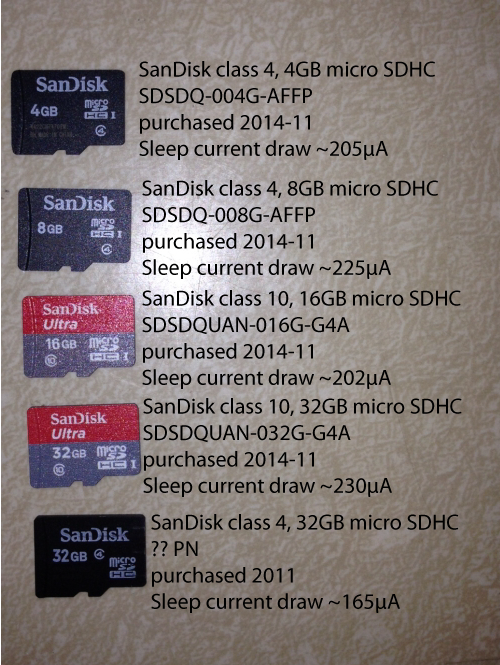As outlined in an earlier post, I found that certain old micro SD cards were performing spectacularly poorly when it came to power consumption because they failed to go into a low-power sleep state immediately after writing data to the card. I recently purchased a few new SanDisk micro SD cards in various capacities to see how they behaved. I purchased 4GB, 8GB, 16GB, and 32GB SanDisk cards from Amazon in November 2014. These were all tagged as “Ships from and sold by Amazon.com” and ranged from $5.99 to $12.99.
The good news is that all 4 cards behaved properly when probed on the oscilloscope. They went back into a low-power sleep mode immediately after all write operations, and each write operation took about the same amount of time (~40ms, but this is totally dependent on the amount of data being written). I also compared these new cards against an older SanDisk class 4 32GB card that I had purchased for a cell phone back in 2011.
I put each card in turn into the same Open Wave Height Logger prototype and attempted to measure the current draw while the OWHL was asleep using an Amprobe AM-220 multimeter set to the µA range. The current draw of the OWHL while asleep without a SD card is approximately 85µA. The values shown below are the added current draw due to the SD card being present in the circuit, and these current draw values may not be representative of what you would see in your own project, since the card’s status will also be affected by the way I have put the OWHL to sleep. The 4 new cards are reasonably close to each other, with the 8GB card having a slightly higher draw than might be expected based purely on capacity. The surprising standout was the old (2011) 32GB card, which has a substantially lower idling current draw than the new cards. Too bad I no longer know where I got this card.

For the OWHL project, a 4GB card might not be sufficient capacity for multiple months, since a continuous sampling regime (4Hz for 24hrs a day) produces about 500MB worth of csv files in a month. The 16GB card might be a decent choice since it has a low current draw, but the ~25µA span observed in the 4 new cards means they’re not radically different, and there’s probably plenty of error in these measurements.
I should also note that some of those old cards from 2008 had lower idling/sleeping current draws than any of the cards shown above (on the order of ~70µA), but that value was meaningless in my application where the card is being accessed once a second, and those old cards were staying powered up for an extra 300ms (consuming 10-20 milliamps) after each write event doing absolutely nothing except helping keep the OWHL warm. The only way to properly see that problem was on an oscilloscope, since a slow handheld multimeter makes it look like they’ve got a super low current draw.